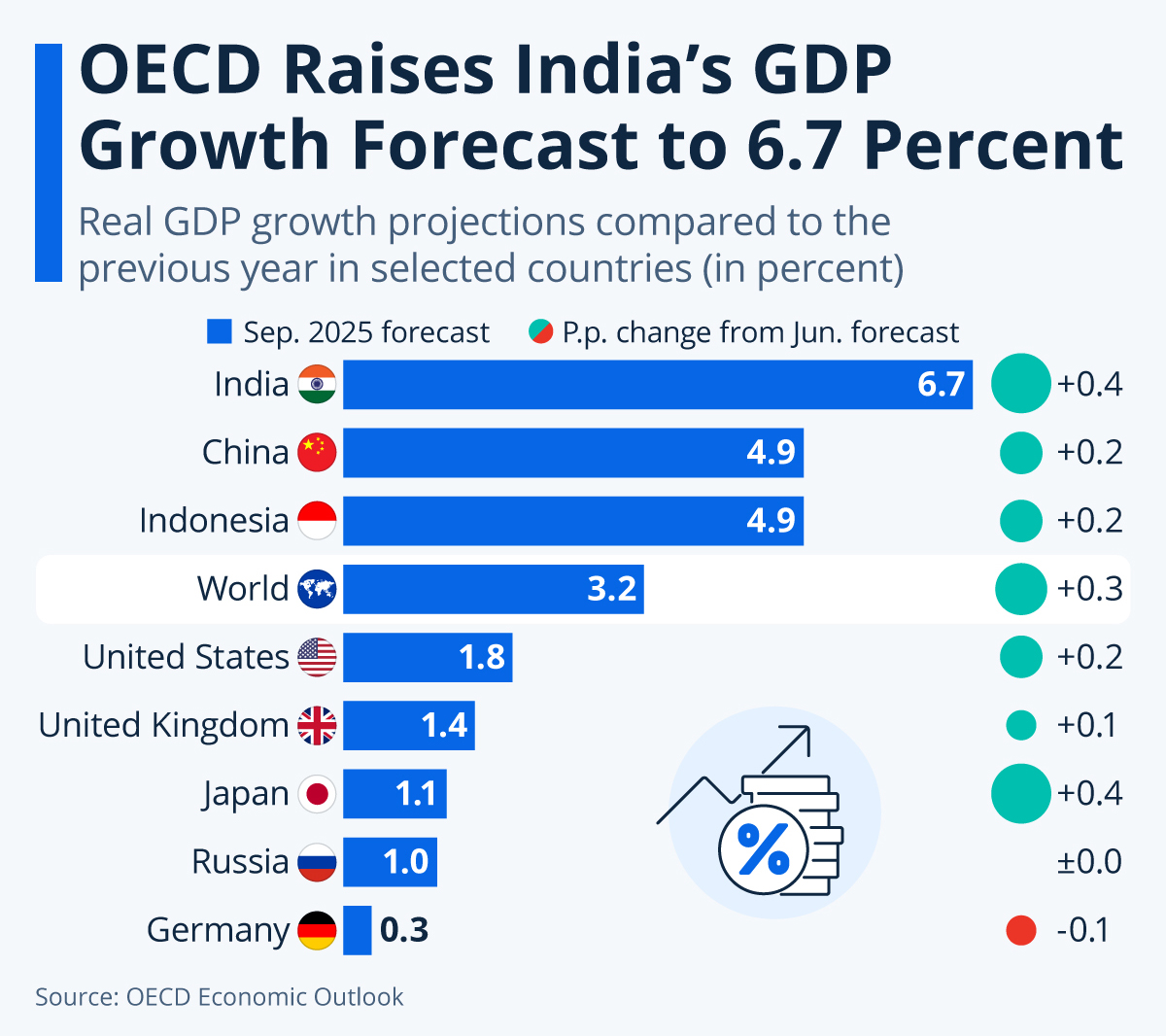Context:
The OECD, in its interim economic outlook, has upgraded India’s GDP growth forecast for 2025 (FY26) to 6.7%, up from its earlier June estimate of 6.3%. Simultaneously, it has lowered the inflation projection to 2.9% from its earlier estimate of ~4.1%. For 2026, the OECD expects growth to slow slightly to 6.2%, with inflation staying near 3%.
Reasons for Upward revision:
1. Robust Domestic Demand
Consumption continues to be strong, cushioned by income growth, favorable monsoon effects, tax incentives, and policy support.
2. GST Reforms & Tax Measures
The OECD notes that reforms to the Goods & Services Tax (GST), including a two‑slab structure (5% and 18%) for many items, along with other fiscal incentives, are expected to stimulate consumption and ease inflationary pressures.
3. Easing Food Price Inflation
A sharper than expected decline in food inflation (due to good supply and, in some cases, export restrictions) is helping to bring down headline inflation.
4. Monetary & Fiscal Support
The OECD expects further monetary easing (as inflation falls) and sustained public investment to support growth momentum.
5. Resilience despite External Risks
Though India faces headwinds (such as higher U.S. tariffs on Indian exports), its large domestic market and growth drivers provide a cushion.
Global Growth & Economic Momentum:
- The global economy proved more resilient than expected in the first half of 2025, driven by front‑loading of goods production and trade ahead of tariff hikes, especially by the United States.
- Global GDP growth is projected to decline from 3.3% in 2024 to 3.2% in 2025 and further slow to 2.9% in 2026.
- In advanced economies (G20), growth is expected to moderate as heightened tariff burdens, policy uncertainty, and fading demand weigh on investment and trade.
Regional Highlights:
-
- United States: Growth is projected to drop from ~2.8% in 2024 to 1.8% in 2025, and further to 1.5% in 2026. The report cites the negative impact of higher effective tariff rates, a decline in net immigration, and policy uncertainty as drag factors.
- Euro Area: Growth is forecast at 1.2% in 2025 and weakening to 1.0% in 2026, with trade friction and geopolitical risks being key headwinds.
- China: Expected to grow ~4.9% in 2025 and ~4.4% in 2026, as front‑loading benefits fade, fiscal stimulus wanes, and export pressures intensify.
- United States: Growth is projected to drop from ~2.8% in 2024 to 1.8% in 2025, and further to 1.5% in 2026. The report cites the negative impact of higher effective tariff rates, a decline in net immigration, and policy uncertainty as drag factors.
About OECD:
The Organisation for Economic Co‑operation and Development (OECD) is an intergovernmental organisation composed of 38 member countries.
· It was officially founded in 1961, succeeding the OECD’s precursor, the Organization for European Economic Co‑operation (OEEC). Its mission is to promote policies that improve economic and social well‑being around the world.
Conclusion:
The OECD's revised forecast reflects India's strong economic fundamentals and growth potential. While challenges persist, particularly in the form of global trade uncertainties and US tariffs, India's resilient domestic demand and policy reforms are expected to drive continued economic growth







